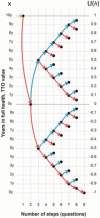Health utilities in cancer patients: A study protocol for a prospective, longitudinal cohort using online survey
- PMID: 30817585
- PMCID: PMC6831185
- DOI: 10.1097/MD.0000000000014647
Health utilities in cancer patients: A study protocol for a prospective, longitudinal cohort using online survey
Abstract
Background: Cost-utility analysis (CUA) is becoming more commonly used in healthcare decision-making. CUA uses the quality-adjusted life-years (QALY) metric, which combines the length of life with the health-related quality of life (HRQoL). Most QALY-measuring instruments were validated for general populations. For patients with cancer, the perception of their health state is different and may vary by the type of cancer considered. In Quebec, no preference weights for QALY have been developed, neither for the general population nor particular subpopulations.
Methods/design: This survey is a prospective, longitudinal cohort study. The study objectives are: to assess the extent of difference in health utilities between the general population and patients with breast or colorectal cancer; to develop a QALY preference weights dataset for patients with cancer; and to perform "mapping" with different HRQoL questionnaires by correlating the SF-6Dv2 with the EQ-5D-5L, European Organization for Research and Treatment of Cancer Quality of Life Questionnaire C30, and functional assessment of cancer therapy - general questionnaires. Data will be collected via a self-administered online survey. Patients' health utilities will be measured within 2 days before the beginning of a chemotherapy treatment cycle and about 8 days after the start of the chemotherapy. Health utilities will be measured by a hybrid method using the time-trade-off and discrete choice experiment methods.
Ethics and dissemination: The proposed research was reviewed and approved by the Institutional Research Ethics Review Boards of the CHUS. We will disseminate our study findings through peer-reviewed publications and conference presentations.
Conflict of interest statement
The authors declare no conflicts of interest.
Figures





References
-
- Brazier J, Ratcliffe J, Saloman J, et al. Measuring and Valuing Health Benefits for Economic Evaluation. Second Edition. Oxford University Press: New York; 2007.
-
- McHorney CA, Ware JE, Lu JF, et al. The MOS 36-item Short-Form Health Survey (SF-36): III. Tests of data quality, scaling assumptions, and reliability across diverse patient groups. Med Care 1994;32:40–66. - PubMed
-
- Aaronson NK, Ahmedzai S, Bergman B, et al. The European Organization for Research and Treatment of Cancer QLQ-C30: a quality-of-life instrument for use in international clinical trials in oncology. J Natl Cancer Inst 1993;85:365–76. - PubMed
-
- Osoba D, Aaronson N, Zee B, et al. Modification of the EORTC QLQ-C30 (version 2.0) based on content validity and reliability testing in large samples of patients with cancer. The Study Group on Quality of Life of the EORTC and the Symptom Control and Quality of Life Committees of the NCI of Canada Clinical Trials Group. Qual Life Res 1997;6:103–8. - PubMed
-
- Cella DF, Tulsky DS, Gray G, et al. The Functional Assessment of Cancer Therapy scale: development and validation of the general measure. J Clin Oncol 1993;11:570–9. - PubMed
MeSH terms
LinkOut - more resources
Full Text Sources
Medical

